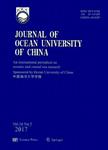Eddies in the Northwest Subtropical Pacific and Their Possible Effects on the South China Sea
Eddies in the Northwest Subtropical Pacific and Their Possible Effects on the South China Sea作者机构:Physical Oceanography and Ocean-Atmosphere Interaction and Climate Laboratory Ocean University of China Qingdao 266003 P.R. China Department of Industrial Engineering Texas A & M University College Station TX 77843-2132 U.S.A.
出 版 物:《Journal of Ocean University of China》 (中国海洋大学学报(英文版))
年 卷 期:2005年第4卷第4期
页 面:329-333页
学科分类:070702[理学-海洋化学] 07[理学] 0707[理学-海洋科学]
基 金:This work is supported by Chinese NSFC(No.40333030) was part of the Research Experience for Undergraduates in Marine Science and Environmental Engineering in China funded by the U.S.National Science Foundation
主 题:eddy drifter South China Sea North Subtropical Pacific
摘 要:Based on an analysis of drifter data from the World Ocean Circulation Experiment during 1979-1998, the sizes of the eddies in the North subtropical Pacific are determined from the radii of curvature of the drifter paths calculated by using a non-linear curve fitting method. To support the drifter data results, Sea Surface Height from the TOPEX/POSEIDON and ERS2 satellite data are analyzed in connection with the drifter paths. It is found that the eddies in the North Pacific (18°-23°N and 125°-150°E) move westward at an average speed of approximately 0.098 ms-1 and their average radius is 176 km,with radii ranging from 98 km to 298 km. During the nineteen-year period, only 4 out of approximately 200 drifters (2%)actually entered the South China Sea from the area adjacent to the Luzon Strait (18°-22°N and 121°-125°E) in the winter. It is also found that eddies from the interior of the North Pacific are unlikely to enter the South China Sea through the Luzon Strait.



